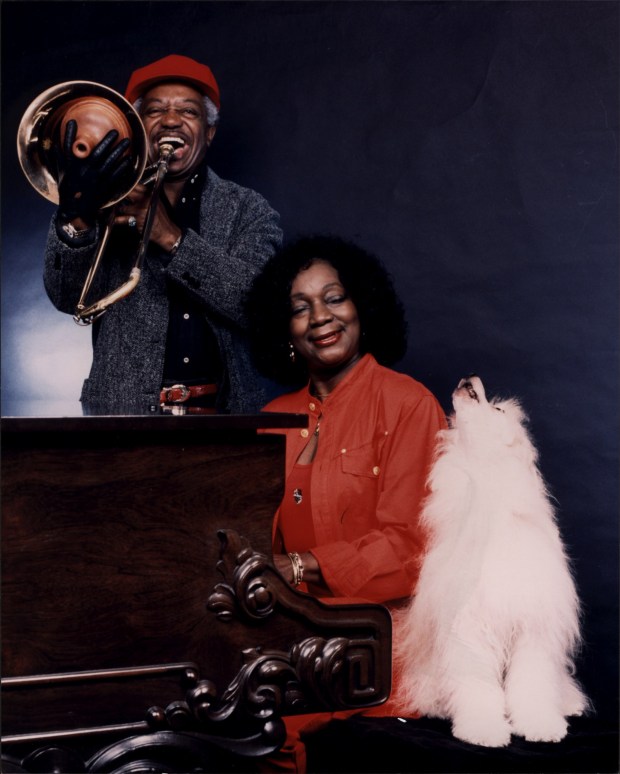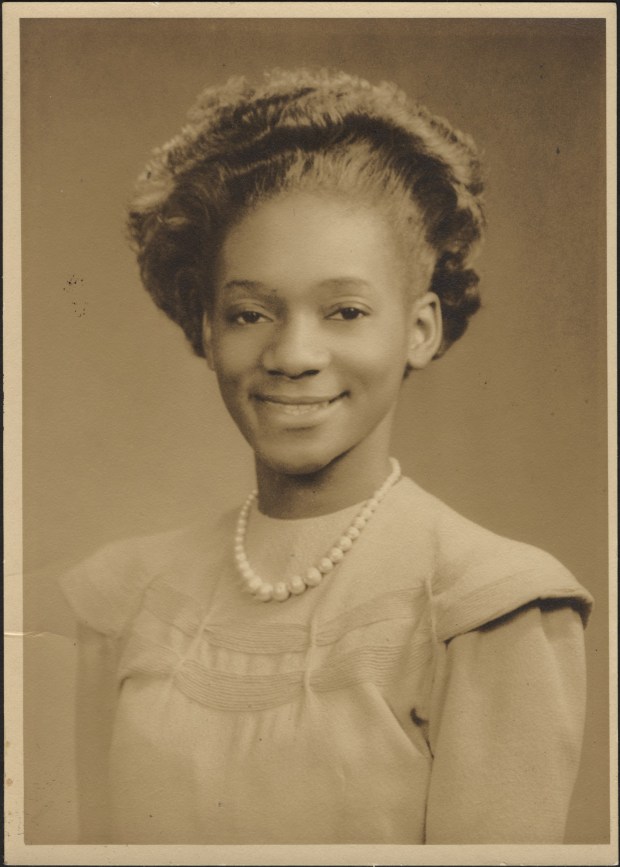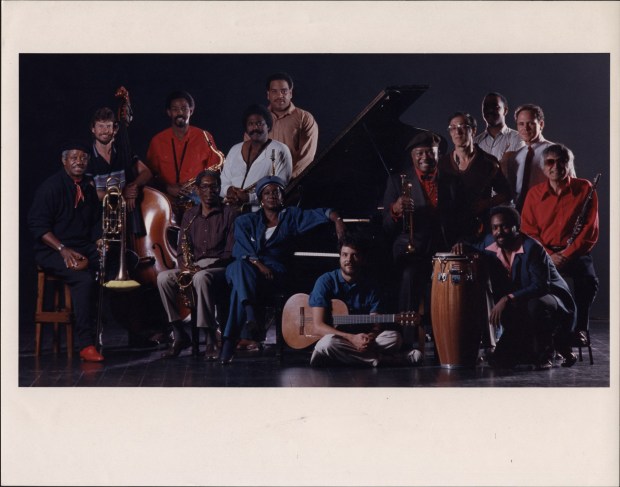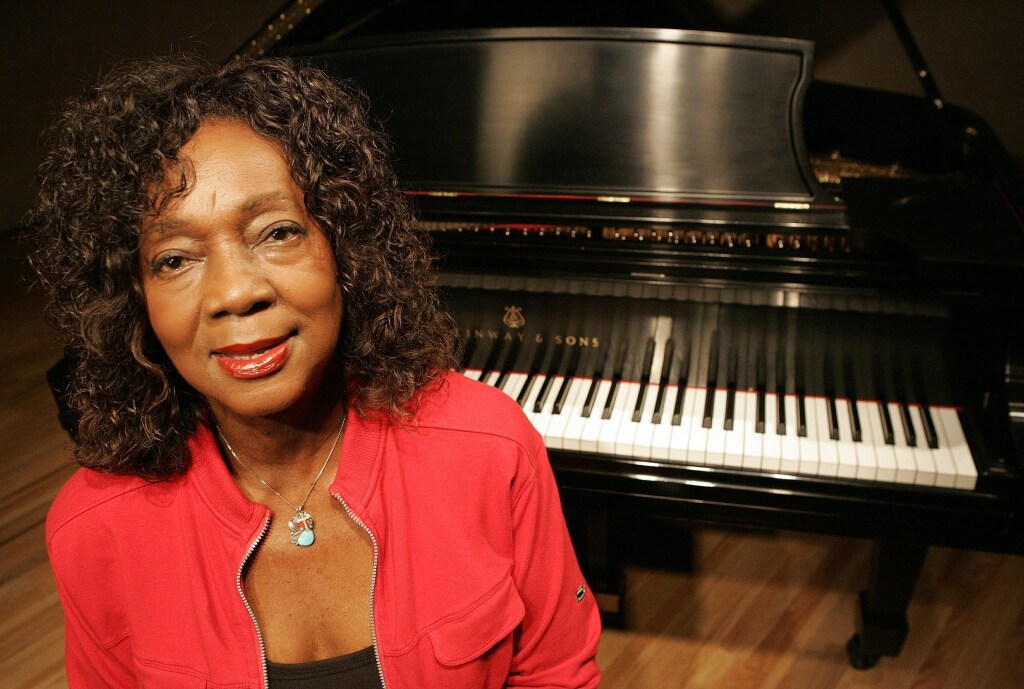Jeannie Cheatham has several good reasons she isn’t paying much attention to her impending 98th birthday on Thursday. “I’m busy!” she said, adding with a chuckle: “My 100th birthday will be the big one for me to celebrate.”
True to her word, this seemingly tireless San Diego dynamo is at work on several fronts. Topping the list is her quest to make an audio version of her heralded 2006 University of Texas Press-published autobiography, “Meet Me With Your Black Drawers On: My Life In Music.”
That musical life began when she did her first paid gig — at the age of 4 — playing keyboards at a church in her Ohio hometown of Akron. She went on to collaborate with such vital American music standouts as Cab Calloway, Bo Diddley, T-Bone Walker, Odetta, Jay McShann, Big Mama Thornton, Johnny Ray and a good number more.
The first part of her book’s title is drawn from the signature song that she wrote for the international award-winning “Sweet Baby Blues.” It was the 1985 debut album by pianist-vocalist Jeannie, her bass trombone-playing husband, Jimmy, and their ebullient Sweet Baby Blues Band. The couple made seven additional albums for Concord Records with the brassy ensemble, which the Cheathams co-led until Jimmy’s death in 2007 at the age of 82.
 Jimmy and Jeannie Cheatham pose with a four-legged friend for a 1996 photo shoot for Southern California Dog Magazine. (Meredith French)
Jimmy and Jeannie Cheatham pose with a four-legged friend for a 1996 photo shoot for Southern California Dog Magazine. (Meredith French)
‘Christmas-song staple’
Jeannie doesn’t perform in public anymore, although she still has a keyboard, writes poems and often sings in her University City-area home. She is considering penning a new book, specifically about the musicians who played in the Sweet Baby Blues Band’s various lineups.
“The guys who were in the band, all of them were pretty special,” she said. “Some died, some lived, and all of them were of service. They would do volunteer work. Each one of them helped people.”
But the possibility of a new book will have to wait, at least for now. A bigger priority for Jeannie is looking at options for a new recording of “An Apple, An Orange and a Little Stick Doll.” She wrote and sang the blues- and country-tinged ballad, which was recorded by the Sweet Baby Blues Band for the all-star 2003 compilation album, “A Concord Jazz Christmas.”
“We didn’t want to do an old traditional Christmas song, so I wrote a new one and Jimmy did arrangements for French horns,” Jeannie said.
“The song has 74,000 streams on Spotify and I don’t even know who put the song up there. I’m not computer-smart, so it shocked me. My daughter Shirley, who is 74, found it on Spotify and told me about it. I’m seeing if we can do a new video version, so people could buy it every year. I think it could become a Christmas-song staple.”
Jeannie also wants to explore having all the Sweet Baby Blues Band’s albums reissued in physical form and made available for streaming. But Concord Records has undergone several changes of ownership in recent decades and it’s unclear who is now best suited to help her pursue reissues and streaming.
“Universal Music Group distributes Concord, but I don’t know how to approach the president of Universal and I’m kind of scared to,” she said. “The people I knew who used to be at Concord have all died or disappeared, and I can’t sell the records from my house. At my age, when everybody dies, you don’t know who to contact.”
 Sippie Wallace, Big Mama Thornton and Jeannie Cheatham are shown in 1986 at the Belly Up in Solana Beach. Their joint concert was filmed for the KPBS-TV special, “Three Generations of the Blues.” (Grace Bell)
Sippie Wallace, Big Mama Thornton and Jeannie Cheatham are shown in 1986 at the Belly Up in Solana Beach. Their joint concert was filmed for the KPBS-TV special, “Three Generations of the Blues.” (Grace Bell)
‘Sharp as a tack’
It is not uncommon for the plucky Jeannie to answer phone calls by declaring: “I’m still alive!”
That she is keeping so active, nearly a full century after her birth, is startling only to those who don’t know her well.
“It doesn’t surprise me at all. She’s always been very engaged and business savvy,” said top San Diego flutist Holly Hofmann, who cites Jeannie as an early role model.
“It’s totally in character that Jeannie keeps so busy,” agreed close friend and photographer Grace Bell, who shot the cover art for four of the Sweet Baby Blues Band’s albums. “She is still sharp as a tack and totally engaged,”
Those sentiments are shared by New York drummer and band leader Sipho Kunene.
“It surprises me that anybody would be doing all that at 97 or 98, but because I know Jeannie, no, it doesn’t surprise me,” he said. “She’s full of creative ideas, all the time.”
Kunene, 66, was a teenager when he befriended the Cheathams in the early 1970s. At the time, both Jimmy and Jeannie were on the faculty at the University of Wisconsin in Madison, where Jimmy taught jazz and Jeannie taught African-American history. Kunene has been overseeing Jeannie’s website, jeanniecheatham.com, for the past four years.
“Pretty much all the content is hers,” the drummer said. “She’ll say what songs and videos she wants on it. Even though she’s not technically minded and doesn’t have a computer, she’s got great instincts. She comes up with solutions to things I hadn’t even thought of!”
Jeannie’s can-do spirit has been a constant since she was a little girl in her native Akron, Ohio, where she was born Jean Elizabeth Evans on Aug. 14, 1927. She took classical piano lessons two hours a day and music quickly became her raison d’etre.
 Jeannie Cheatham is 16 in this 1943 photo of her as a soon-to-graduate student at West High School in Akron, Ohio. (Courtesy Marr Sound Archives, University of Missouri)
Jeannie Cheatham is 16 in this 1943 photo of her as a soon-to-graduate student at West High School in Akron, Ohio. (Courtesy Marr Sound Archives, University of Missouri)
Beethoven, Charlie Parker
“My music teacher was an Englishman,” she recalled. “When I was 6 or 7, he would take me to White churches and I would play Beethoven. I was comfortable doing that.”
She was transformed after hearing the 1940 recording of the now classic “After Hours” by Erskine Hawkins & His Orchestra. The song was written by Avery Parrish, whose soulful, oh-so-supple piano playing on “After Hours” proved foundational for Jeannie.
“Avery Parrish was the first and only pianist I listened to,” she said. “I would always listen to the trumpet players or saxophonists and try to imitate them. That’s my secret and that’s why I think my piano style is different.
“The singers who really moved me were Lee Wiley, who most people have never heard of, and Billie Holiday. I also loved Edith Piaf. She sang in French, but her music touched me. And I cut my teeth on (bebop sax icon) Charlie Parker.”
By the time she was in her early teens, Jeannie was performing with a 12-piece Akron band. She went on to play piano for such esteemed vocal stars as Dinah Washington, Jimmy Witherspoon, Wynonie Harris, Joe Williams, Big Maybelle and Jimmy Rushing. Jeannie later shared the same manager as Ella Fitzgerald.
She thrived despite encountering racism and sexism as a Black female musician in a decidedly male-dominated field during the still-segregated 1940s and 1950s.
“They always would say: ‘Oh, she plays really good — for a girl’,” Jeannie said. “But it wasn’t that difficult for me. I tell young women musicians: ‘Don’t wait for men musicians to hire you — lead your own band. You hire them. Don’t wait for them to hire you’.”
Jeannie spent three years playing with an American band in Toronto. After their last performances on Saturday nights, the group would hurriedly drive 90 miles to Buffalo, N.Y., for a breakfast-jazz set. It was there Jeannie memorably met her husband-to-be, Jimmy, in the mid-1950s.
“Me and my girlfriend were all dressed up and saw him at a jam session,” she recalled. “I told the barmaid: ‘Send that guy a drink.’ The barmaid said: ‘That’s Jimmy Cheatham,’ and walked up to him with a drink on her tray. He said he didn’t want it.
“I told her: ‘Take it back and tell him to drink it or wear it!’ She did and he laughed and drank it, and that’s how we got together.”
Jimmy Cheatham beamed broadly in a 2006 San Diego Union-Tribune interview as he recalled meeting Jeannie in Buffalo.
“She was something,” he said. “I remember looking at her across the room and thinking: ‘Hmmm.’ At intermission, I noticed her positive spirit right away when I joined her at the bar. I saw she was a beautiful human being with a fantastic mind, and I began to observe her a lot more deeply.”
They married in 1958 and moved two years later to New York City. In between her music gigs, Jeannie studied business management and accounting. Both would later prove invaluable to her when she helped the Sweet Baby Blues Band negotiate the ins and outs of concert and festival bookings, recording contracts and negotiating the group’s 1988 appearances on the Johnny Carson-hosted “Tonight Show.”
Jimmy had been a musical arranger for Broadway shows and performed with such jazz giants as Duke Ellington, Count Basie, Papa Jo Jones, Ornette Coleman, Lionel Hampton and Chico Hamilton. In 1977, Jimmy accepted a teaching position in the jazz department at UC San Diego. He led the school’s jazz ensemble until his retirement in 2005 and has been cited as a key mentor by two now-prominent former students — flutist Nicole Mitchell and bassist Mark Dresser.
 In this 1987 photo of leading San Diego jazz musicians, Jimmy Cheatham is shown at the far left and Jeannie Cheatham is seated at the piano. (Union-Tribune file photo)
In this 1987 photo of leading San Diego jazz musicians, Jimmy Cheatham is shown at the far left and Jeannie Cheatham is seated at the piano. (Union-Tribune file photo)
‘They were ebullient!’
In 1978, Jeannie and Jimmy started their popular weekly Sunday jam sessions, first at the Sheraton Harbor Island, then at the Bahia Hotel. The sessions laid the groundwork for the formation of the Sweet Baby Blues Band in 1993. And the sessions drew enthusiastic audiences, such national jazz stars as pianist Billy Taylor and saxophonists Charles McPherson and Eddie “Cleanhead” Vinson, and many eager young musicians, including flutist Hofmann.
“Jeannie was really important in my introduction to the jazz scene in San Diego when I arrived here in the late 1980s,” said Hofmann, who became one of the city’s top jazz curators and concert promoters.
“At the jam sessions, she and I were almost always the only women. I felt a comfort with Jeannie because my musical life, up to that point, had been exclusively with men. She would play chord changes for me that helped me to create on the spot. After I started doing the jazz series at the Horton Grand Hotel in the 1990s, I hired the Cheathams many times and people loved how joyful they and their music were. They were ebullient!”
That assessment is seconded by the University of Missouri’s Chuck Haddix. He is the curator of the school’s Marr Sound Archives, which in 2009 was gifted with the Jimmy and Jeannie Cheatham Collection.
“The Cheathams embody the good-time spirit of jazz, swing, boogie-woogie and jump-blues, and audiences adored them,” Haddix said.
“Jeannie combines the virtuosity of jazz and the deep feeling of the blues. She has a great history in music and a great respect for the past, but she’s always looking forward.”
Had she decided to be only a pianist or only a singer, Jeannie would still command attention. Her arresting keyboard playing and warm, deeply felt vocals each convey maximum emotion with minimum fuss. And as the heart and soul of The Sweet Baby Blues Band, she was a potent musical force.
“We played the Kansas City style, but what we did was also the history of Black music, she said. “I taught it and Jimmy taught it, and the guys in the band had to know how to play it. When I counted in a song by saying ‘One, two, you know what to do,’ they better know what to do!”
Jeannie’s commanding presence, on stage and off, is a matter of record.
“She has an amazing ability to get people together, organize them and have them perform in a beautiful way. She brings out the best in people,” said photographer Bell.
“You can never under-estimate her at all,” agreed fellow photographer Meredith French, who has also known Jeannie for decades.
“Whenever we did photo shoots with her and Jimmy, she was always the star of the show and Jimmy was happy to oblige. Jeannie always wore red, which was her trademark, for our photo shoots. That was the one thing she insisted on. Otherwise, there were no restrictions.”
Why red?
“Red is for energy,” Jeannie said. “I found out — wherever I was — that when you want to get on stage and raise the energy, you wear red. It’s a happy color.”
A fan with two medics
Over the years, Jeannie and Jimmy led the Sweet Baby Blues Band in performances at the Hollywood Bowl, the New Orleans Jazz & Heritage Festival, France’s Nice Jazz Festival and Japan’s Fujitsu-Concord Jazz Festival. But one of the most memorable came when the group appeared in The Netherlands at the 1987 North Sea Jazz Festival.
Their 1 a.m. performance drew a boisterous, near-capacity audience despite the fact that they were directly competing against simultaneous concerts by the Modern Jazz Quartet, Michael Brecker, Stanley Jordan, the Dirty Dozen Brass Band, Roomful of Blues, Woody Shaw and Albert Collins.
One of the Cheathams’ devoted fans had come straight from the hospital. He was in the center of the audience, on a wheeled stretcher, carefully attended by two medics. The ailing man was in no condition to give a quote to this reporter, but he visibly enjoyed the music.
“And he had one of his arms hanging above him in traction!” Jeannie recalled.
“It was one of the highlights of our career and it still gives me the chills. It reminds me that music is magic and it raises a vibration. When we get on stage, we’re all happy to see each other and we know something good will happen, and it does. I’ll never forget that night at the North Sea Jazz Festival as long as I live.”
And how long might that be?
“I don’t know, but right now I’ve got several balls in the air,” Jeannie said. “You want to know how I feel at nearly 98? I don’t feel no different than I did at 28. My mother lived to be 102 and my grandmother lived to be 107. So, I’m keeping busy. I’m not sitting around.”
